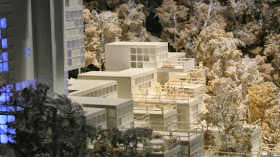RICHARD ROGERS RA: INSIDE OUT
ROYAL ACADEMY OF ARTS BURLINGTON GARDENS
CURATOR JEREMY MELVIN
18 July 2013 – 13 October 2013
RICHARD ROGERS RA: INSIDE OUT
ROYAL ACADEMY OF ARTS BURLINGTON GARDENS
CURATOR JEREMY MELVIN
18 July 2013 – 13 October 2013
Richard Rogers RA: Inside Out will explore the ideas and ethos of
the internationally renowned architect and urbanist Lord Rogers of Riverside.
Timed to coincide with Rogers’ 80th birthday, the exhibition will examine his
social, political and cultural influences and their connection to his
architecture. Previously unseen original material, drawings and personal items,
will present a unique insight into the thinking behind one of the world’s most
celebrated architects. Richard Rogers RA: Inside Out will be held in Burlington
Gardens, the Royal Academy’s new venue for contemporary art and architecture.
The exhibition will draw on key stages in Rogers’ life, from the influence of
his Italian family, his experience of wartime and post-war Britain, his education
at the Architectural Association and Yale, and the impact of seeing new
American architecture and technology. Visitors
will be introduced to Rogers’ principles through the presentation of major
projects and collaborations, revealing his pioneering ideas about architecture
and his belief in the need to create vibrant cities for everyone.
Rogers has consistently worked with themes that are far wider than
conventional architectural thinking, articulating them as a spokesperson,
writer, politician and activist, as well as an architect. For over half a
century, Rogers has advocated the social objectives of architecture, the
importance of public space, urban regeneration and better planning, through
innovative design. He has played a pivotal role in master-planning and shaping
government policy on urban development, believing that architecture is the most
powerful agent for social change.
A number of high-profile projects that incorporate Rogers’
architectural principles will be showcased. These will include the Centre
Pompidou, designed with Renzo Piano and still considered one of the most
radical modern buildings since its opening in 1977, the Grade 1 listed
headquarters for Lloyd’s of London, and the Bordeaux Law Courts. Through these
projects Rogers has established himself and his practice, Rogers Stirk Harbour
+ Partners, as standing at the forefront of the architecture industry.
The exhibition will bring together the far reaching effects that
Rogers’ interest in the politics of social justice has had on architecture and
public policy.
Richard Rogers comments, “For almost 300 years the Royal Academy
has been at the heart of London’s artistic life, acting as a crucible for vital
critical discourse and as one of the world’s leading exhibition spaces. I am
delighted to have worked alongside the Royal Academy to hold this exhibition. I
believe history judges us on the physical and social quality of our cities, and
this exhibition aims to explore the role of architecture both as a physical
discipline and as a framework to interpret our wider society.”
A series of debates, discussions and an innovative events and
educational programme will support Richard Rogers RA: Inside Out. Focusing on
urban design issues, contributors will include leading architects, politicians
and artists. Many of the events and activities accompanying the exhibition will
take place in a public space specially created inside the exhibition.
ORGANISATION
Richard Rogers RA: Inside Out is organised by Rogers Stirk Harbour
+ Partners (RSH-P) and the Royal Academy of Arts. The exhibition has been
curated by Jeremy Melvin, Consultant Curator for Architecture, Royal Academy of
Arts. The exhibition is designed by Ab Rogers Design with graphics by Graphic
Thought Facility.
I had quoted some photographs from dezeen web page. You may reach
the news to click above both links of Royal Academy of Arts web page and Dezeen
web page to watch video from the exhibition.
ZIP – UP HOUSE COURTESY OF RICHARD
ROGERS
CENTRE POMPIDOU
CENTRE POMPIDOU ELEVATION FROM THE
COMPETITION
CENTRE POMPIDOU PHOTO BY KATSUHISA KIDA
ESCALATORS OF THE CENTRE POMPIDOU
CENTRE POMPIDOU PHOTO BY DAVID NOBLE
The key theme
of the exhibition, Rogers explains, is social responsibility.
"We've
decided to call the exhibition Inside Out, partly because I often put structure
and ducts on the outside of buildings," he says.
"But the
real title is Ethos. The idea is that we have a responsibility to society. And
that gives us a role as architects that is more than just answering the client
but also to answer the passerby and society as a whole."
ABOUT THE ROYAL ACADEMY OF ARTS AND BURLINGTON GARDENS
The Royal Academy of Arts was founded by George III in 1768. It has
a unique position in being an independent, privately funded institution led by
eminent artists and architects. Its public programme promotes the creation,
enjoyment and appreciation of the visual arts through exhibitions, education
and debate. 6 Burlington Gardens was designed by Sir James Pennethorne
(1801-1871) and opened
by Queen Victoria in 1870 as the Senate House of the University of
London. The Royal Academy of Arts has received initial support from the
Heritage Lottery Fund (HLF). This consists of £458,700 development funding
towards a £12.7m HLF bid for The Burlington Project, ‘Revealing, Celebrating
and Exploring the Heritage of the Royal Academy of Arts’.
www.royalacademy.org.uk
CURATOR JEREMY MELVIN
NEW AREA TERMINAL MADRID AIRPORT PHOTO
BY MANUEL RENAU
WIMBLEDON HOUSE SKETCH
WIMBLEDON HOUSE PHOTO BY RICHARD BRYANT
Rogers goes on to explain that he believes that good architecture
is the result of teamwork, rather than one person's vision.
"I work very much with colleagues, with friends," he
says. "Architecture is about teams. The idea that you suddenly wake up and
do a sketch is not true. The only time I do that, I usually wake up with a
hangover the next morning."
Richard Rogers
THE ROOM AT LLOYD’S OF LONDON PHOTO BY
JANET GILL
RICHARD ROGERS’ S OFFICE
RICHARD ROGERS
ROGERS STIRK
HARBOUR + PARTNERS ( RSHP )
Rogers Stirk
Harbour + Partners (RSHP) is an international architectural practice based in
London. Over three decades, RSHP has attracted critical acclaim and awards with
built projects across Europe, North America and Asia. The practice is
experienced in designing a wide range of building types including: office,
residential, transport, education, culture, leisure, retail, civic and
healthcare. The quality of its designs has been recognised with some of
architecture’s highest awards, including two RIBA Stirling Prizes, one in 2006
for Terminal 4, Madrid Barajas Airport and the other in 2009 for Maggie’s
London.
RSHP employs
around 200 people, including 9 Partners, 10 Associate Partners and 57
Associates, in offices across the world – London, Sydney and Shanghai. A
‘Think Tank’ philosophy is employed at every level, to enable design and
management leaders to collaborate and contribute their individual expertise.
Weekly meetings – open to all employees – provide a vital forum for discussion
of current competitions and on-going projects, as well as a platform for
creativity and new solutions appropriate to each design. This ‘collegiate’
approach to the work of the practice is embodied in a constitution that
consciously brings a moral dimension to our work and takes the form of, among
other initiatives, a staff profit-sharing scheme and significant contributions
to charity, with staff members nominating the charities of their choice.
RSHP
Chairman, Richard Rogers, is the 2007 Pritzker Architecture Prize Laureate, winner
of the 2000 Praemium Imperiale Prize for Architecture and the recipient of the
RIBA Gold Medal in 1985. Richard was awarded the Légion d’Honneur in 1986,
knighted in 1991 and made a life peer in 1996. He was Chief Advisor on
Architecture and Urbanism to the former Mayor of London, Ken Livingstone and
has played an advisory role on design to the current Mayor of London, Boris
Johnson. He has acted as Chairman of the British Government’s Urban Task Force
and was a member of the Mayor of Barcelona’s Urban Strategies Advisory Council.
Richard
Rogers Partnership became Rogers Stirk Harbour + Partners in 2007 to reflect
the growing importance of two of the younger Partners, Graham Stirk and Ivan
Harbour, and their role alongside Richard Rogers in the practice’s future.
Together with other long-standing Partners, Stirk and Harbour represent the
inherent continuity and consistency of the philosophy which the practice
applies to all its work. The name change also demonstrates the practice’s
confidence in its ability to continue to meet those challenges still to come.
Principles
Over three
decades, RSHP (formerly Richard Rogers Partnership) has evolved a set of core
principles that guide all our work:
CITY &
CONTEXT
At RSHP, we
believe that cities are the physical framework of our society, the generator of
civil values, the engine of our economy and the heart of our culture. Compact,
multi-centred cities are the only environmentally sustainable form of urban
development for future generations. They are a rational and economical way of
creating human settlements that offer a high quality of life.
Public space
between buildings influences both the built form and the civic quality of the
city, be they streets, squares or parks. A balance between the public and
private domain is central to the practice's design approach. Buildings and
their surrounding spaces should interrelate and define one another, with
external spaces functioning as rooms without roofs.
Work, leisure
and domestic activities are becoming interchangeable, leading to the creation
of open-ended, flexible structures. The structure of buildings set the scale,
form and rhythm of the architectural environment, within which change and
improvisation can take place. The practice searches for a more subtle world
between solid and transparent, a sequence of spaces where the eye is led
through overlapping strata, where light and shadow enhance the impression of
transparency.
Today's
buildings are more like evolving landscapes than classical temples in which
nothing can be added and nothing can be removed. Open ended, adaptable
frameworks with large, well-serviced and well-lit floors, on the other hand,
offer the possibility for a long life span for the building and a variety of possible
uses.
It has become
clear that the risk associated with climate change will pose serious challenges
to society. Buildings, neighbourhoods and cities should be designed to minimise
pollution and carbon emissions. This implies not only using renewable energy
sources (including wind, sun and water), but designing energy efficient
buildings and masterplans that encourage vegetation and biodiversity.
RSHP believes
that a strong social vision is the driving force behind a happy and productive
workforce, which is critical for the development of a sustainable civil
society. With this in mind the practice has produced a constitution that
enshrines ideas about community, teamwork, equity, collaboration and social
responsibility.






































































